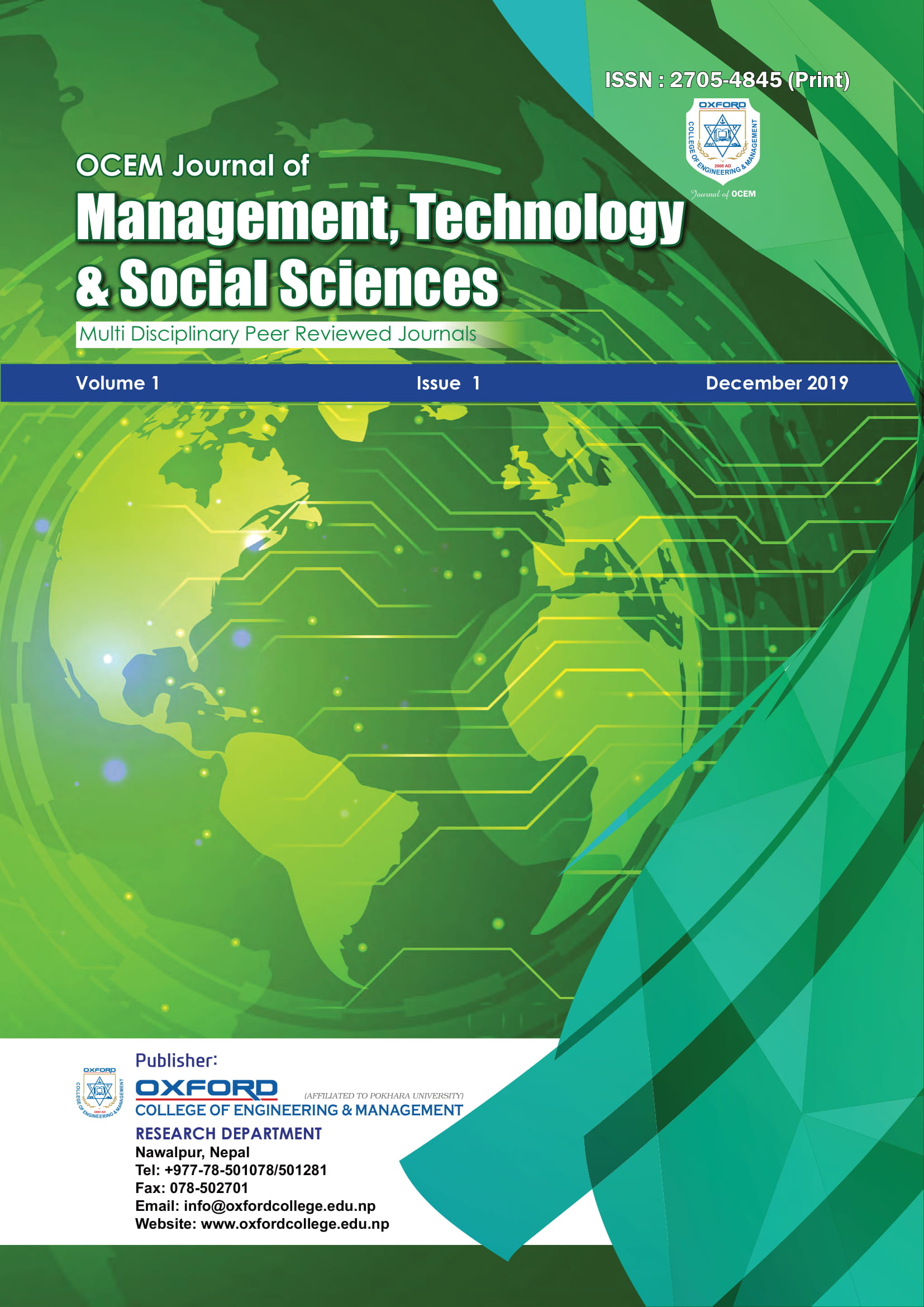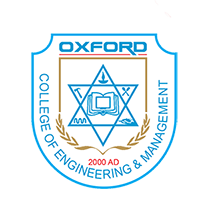Student Satisfaction at Secondary Level in Oxford College of Engineering & Management
Abstract
The objective of this study was to examine the student satisfaction level at grade 11 and grade 12 in Oxford College of Engineering and Management (OCEM). Quantitative methodology approach along with the survey study was applied in this study. The survey questionnaire was used as research instrument to collect data in this study. The target population was four hundred and fourty and the sampled population was two hundred and four. There were two hundred and four (N= 204) respondents where the boy’s population was 55.88 % and girl’s population was 41.11 %. The response rate was
94.22%. The Cronbach’s Alpha was calculated to find the reliability of the data. Independent sample ttest was used to find the differences between the male and female students’ intention to recommand for the enrollment of their kith and kin at OCEM. The previous studies reveal that students’ satisfaction at the secondary level schools were embedded in the factor of quality of education, school administrative factor, managerial factor, psysical factor and school location. The results show that lifelong academic skills, standard and qualified lecturers, student centered activities, strong faculty management, proactice faculty support, better college environment and facilities, punctuality of the transfort facilities, strong security environment, better lab facilities and advanced library facilities, advanced physical facilities and college infrastructure facilities were extracted as the key subscales of the analysis section. The results show that there was significant relationship between existing students’ recommendation to enrol and student centered activities, advanced lab and library facilities and college facilities at Oxford College of Engineering and Management (OCEM) at Nawalpur of Nepal (p < 0.05, B = -.342, B = -.309. B = -.398).
The implications of findings will be beneficial for college principals, school leaders, academicians, Head of Department, college promoters to formulate student centered strategies. It will be also useful to college policy makers to formulate new student-centered strategy to motivate students for the enrolment. In generalizing the results of the present study, there is some cause for concern due to a sampling method and representativeness of the boys and girls
Keywords:
student satisfaction, quality of education, school administrative factor, managerial factor, physical factor and school location.Downloads
References
Attreya, B. (2018). Consumer Buying Behaviour. Journal of Advances and Scholarly Researches in Allied Education, 15(9), 1-4.
Butt, B. & Rehman, K. (2010). A study examining the students’ satisfaction in higher education. Procedia - Social and Behavioral Sciences, 2(2), 5446-5450.
Calder, N. (2013). Mathematics in student-centred inquiry learning: Student engagement. Teachers And Curriculum, 13. doi: 10.15663/tandc.v13i0.15
Cohen, L., Manion, L. and Morrison, K. (2011). Research methods in education. London: Routledge. Gajic, J. (2011). Measurement of student satisfaction in higher education. Marketing, 42(1), 71-80.
Gruber, T., Fuß, S., Voss, R. and Gläser‐Zikuda, M. (2010). Examining student satisfaction with higher education services. International Journal of Public Sector Management, 23(2), 105-123.
Hanssen, T. and Solvoll, G. (2015). The importance of university facilities for student satisfaction at a Norwegian University. Facilities, 33(13/14), 744-759.
Hernadewita et al., H. (2019). PLS-SEM Based Analysis of Service of Learning, Service Quality and Satisfaction of College Student in Polytechnic. International Journal of Mechanical and Production Engineering Research and Development, 9(3), 861-870.
Hossain, M. J. & Islam, M. A. (2012) Understanding perceived service quality and satisfaction: A study of Dhaka University Library, Bangladesh. Performance Measurement and Metrics, 13, 169-182.
Insch, A. and Sun, B. (2013). University students’ needs and satisfaction with their host city. Journal of Place Management and Development, 6(3), 178-191.
Kärnä, S. and Julin, P. (2015). A framework for measuring student and staff satisfaction with university campus facilities. Quality Assurance in Education, 23(1), 47-66.
Kreber, C. (2009). Academics’ teacher identities, authenticity and pedagogy. Studies in Higher Education, 35(2), 171-194.
Kwun, D. J. W., Ellyn, E. & Choi, Y. (2013) Campus Foodservice Attributes and their Effects on Customer Satisfaction, Image, and Word-of-mouth. Journal of Foodservice Business Res
Langstrand, J., Cronemyr, P. and Poksinska, B. (2014). Practise what you preach: quality of education in education on quality. Total Quality Management & Business Excellence, 26(11-12), 1202-1212.
Mihanović, Z., Batinić, A. and Pavičić, J. (2016). The link between students’ satisfaction with faculty, overall students’ satisfaction with student life and student performances. Review of Innovation and Competitiveness, 2(1), 37-60.
Mukhtar, U., Ahmed, U., Anwar, S. and Baloch, M.A. (2015). “Factors affecting the service quality of public and private sector universities comparatively: an empirical investigation; Journal of Arts, Science & Commerce; 3(1), 132-142.
Mullamaa, K. (2017). Student centred teaching and motivation. Advances In Social Sciences Research Journal, 4(16). doi: 10.14738/assrj.416.3593
Nogueira, M. (2018). Measuring Academic Life Satisfaction in Portuguese Students. Nursing & Healthcare International Journal, 2(1), 21-25
Prentice, G., Brady, J. and McLaughlin, C. (2018). Education Service Quality, Value and Satisfaction on Student Customer Intentions and Behaviour. DBS Business Review, 2.
Quality Improvement Based on a Process Management Approach, with a Focus on University Student Satisfaction. (2016). Acta Polytechnic a Hungarica, 13(6). http://dx.doi.org/10.12700.
Sahayogee, J. (2019). Best Wishes For First Day of College - Good Luck Messages & Quotes. Retrieved 4 November 2019, from https://bestwishes.imnepal.com/best-wishes/lifestyle/best-wishes-first- day-college-good-luck-messages-status-quotes/
Sweeney, L (2016). A Predictive Model of Student Satisfaction,” Irish Journal of Academic Practice: 5(1), p.1-31 (https://arrow.dit.ie/ijap/vol5/iss1/8)
Tucker, B. (2013). Student evaluation to improve the student learning experience: an Australian university case study. Educational Research and Evaluation, 19(7), 615-627.
Uprety, R. and Chhetri, S. (2014). College Culture and Student Satisfaction. Journal of Education and Research, 4(1), 77-92.
Vogt, W. (2011). SAGE quantitative research methods. Los Angeles [Calif.]: SAGE.
Weerasinghe, I. and Fernando, R. (2018). Critical factors affecting students’ satisfaction with higher education in Sri Lanka. Quality Assurance in Education, 26(1), 115-130.
Yusoff, M., McLeay, F. and Woodruffe-Burton, H. (2015). Dimensions driving business student satisfaction in higher education. Quality Assurance in Education, 23(1), 86-104.
Downloads
Published
How to Cite
Issue
Section
License

This work is licensed under a Creative Commons Attribution 4.0 International License.
© 2024 by The OCEM Journal of Management, Technology and Social Sciences is licensed under CC BY-NC 4.0






